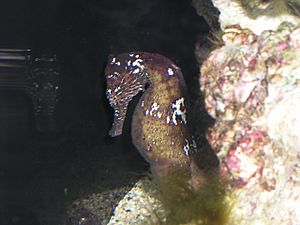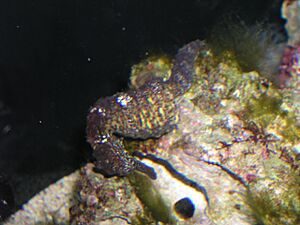Hippocampus kuda facts for kids
Quick facts for kids Hippocampus kuda |
|
|---|---|
 |
|
| Conservation status | |
| Scientific classification |
The Hippocampus kuda, also known as the common seahorse or yellow seahorse, is a special type of fish. It belongs to the Syngnathidae family, which includes other unique fish like pipefishes. These amazing creatures live in the warm waters of the Indo-Pacific region. Sometimes, people call them "sea ponies" because of their horse-like heads!
Contents
What Does the Common Seahorse Look Like?
The yellow seahorse is a small fish. It can grow to be about 17 to 30 centimeters (7 to 12 inches) long.
Its body is quite long and smooth. It does not have sharp spines, only rounded bumps. The seahorse's head is big compared to its body. It has a short, thick snout. On top of its head, it has a small crown-like shape called a coronet. This coronet sometimes has long, thin strands.
Common seahorses can be many different colors. They are often dark with a bumpy texture. But they can also be yellow, cream, or reddish. They might have patches and many small dark spots on their bodies. Some adult seahorses have a black line across their back fin.
Where Do Common Seahorses Live?
The yellow seahorse lives in many places around the world. You can find them from the Persian Gulf all the way to Southeast Asia and Australia. They also live near Japan and several Pacific islands, including Hawaii. On the eastern coast of Africa, they are found from Tanzania to South Africa.
These seahorses live in different kinds of watery homes. They can be found in coastal waters where the bottom is soft or rocky. They also like calm places like estuaries (where rivers meet the sea), harbors, or mangrove forests. Sometimes, they even live in the open ocean. There, they hold onto floating seaweed like Sargassum. They usually live in shallow water, from the surface down to about 8 meters (26 feet) deep. The deepest they have been seen is 55 meters (180 feet).
What Do Common Seahorses Eat and How Do They Reproduce?
The yellow seahorse is a carnivore. This means it eats other animals. They mostly feed on small crustaceans and other tiny creatures that float in the water.
Seahorses have a very special way of reproducing. They are ovoviviparous. This means the mother produces eggs, but the father carries them. The male seahorse has a special pouch on his belly. He keeps the eggs safe inside this pouch. Inside the pouch, tiny blood vessels surround each egg. This creates something like a placenta, which helps feed the baby seahorses as they grow.
When the young seahorses, called pups, are fully grown, they leave the father's pouch. After they leave, they are ready to live on their own.
Why Common Seahorses Need Our Help
The common seahorse is still found in many places, especially in Indonesia and New Guinea. However, experts are worried about them. The IUCN says they are a vulnerable species. This means their numbers are going down, and they could become endangered if we don't help them.
There are a few reasons why they are in trouble:
- Accidental Catch: Sometimes, they get caught by accident in fishing nets, especially nets used for shrimp.
- Being Caught on Purpose: People also catch them for the aquarium trade (to keep as pets) or for traditional medicine.
- Losing Their Homes: Their habitats, like mangrove forests and coral reefs, are being destroyed.
- Slow Reproduction: Seahorses don't have many babies at once. This is because the male takes a lot of time and care to raise the young in his pouch.
Because of these problems, the common seahorse is also listed in Appendix II of the Convention on International Trade in Endangered Species of Wild Fauna and Flora. This means that even though they are not in danger of disappearing completely yet, their trade must be carefully watched. This helps make sure that catching them does not harm their chances of survival.
Common Seahorses as Pets
Common seahorses have very tiny mouths. They can only eat small animals. This includes things like brine shrimp and even newborn guppies. Seahorses need to eat a lot, usually 4 to 5 times a day. Many people who keep these seahorses as pets grow their own brine shrimp and rotifers to feed them. If other foods are not available, seahorses will sometimes eat Daphnia.
Seahorses are not very good swimmers. They spend most of their time holding onto coral reefs or branches with their tails. This is important for them to stay in place. So, if you keep them in an aquarium, they need similar places to hold onto.
Seahorses like a calm tank. They do best without large, aggressive fish around them. They also prefer slow-moving water currents. Some aquarists (people who keep aquariums) have found that seahorses can live peacefully with other calm fish, like Synchiropus splendidus and other fish that live on the bottom of the tank.
Tank Conditions for Seahorses
Common seahorses generally like water temperatures between 22 and 25 degrees Celsius (72-77 degrees Fahrenheit). They don't do well if the water gets too warm, especially above 27 degrees Celsius (80 degrees Fahrenheit).
The water's pH level should be around 8.1 to 8.4. They can handle different levels of saltiness in the water, but about 32 parts per thousand (ppt) is best. If the saltiness drops too low, it should be fixed quickly.
Images for kids
See also
 In Spanish: Hippocampus kuda para niños
In Spanish: Hippocampus kuda para niños




